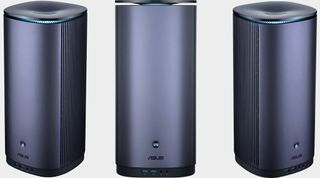When temps get too high, this compact workstation pops its top for added airflow
It stands barely over a foot tall and packs some serious hardware.

Asus on Thursday announced a workstation-class desktop for professional content creation, and what's remarkable about the system is the level of hardware the company was able to shoehorn into a relatively small package.
The new Mini PC ProArt PA90 measures 176mm x 176mm x 356mm (6.9 x 6.9 x 14 inches), so it stands just a little over a foot tall and has a small footprint overall. Despite its diminutive stature, Asus is letting buyers configure the workstation with a Core i9-9900K or Core i7-9700K processor nestled into a Z390 motherboard, with Nvidia Quadro P4000 and P2000 graphics options.
It also boasts four SO-DIMM slots supporting up to 64GB of DDR4-2666 memory (or 2133MHz if filling all four slots), two M.2 slots, and a single SATA 6Gbps port, which comes pre-populated with a 1TB or 500GB hard drive. There's also a spot for an Intel Optane Memory module.
That's a burly collection of hardware, and obviously cooling is a concern with any type of compact system. In this case, Asus says a combination of an all-in-one liquid CPU cooler and an "innovative ventilation system" keeps the system stable. When temps ramp up, the top of the system expands for added airflow.
"For content creators who deal with heavy design workloads daily, system stability and a high-performance cooling system is as essential as a powerful processor. Mini PC ProArt PA90 is equipped with an all-in-one CPU liquid cooler that unleashes the full performance of the CPU while delivering consistently quiet and stable operation. The liquid cooler also enables a quieter working environment, operating at just 32dB at full CPU load, 36 percent quieter than average desktop PCs," Asus claims.
"An innovative ventilation system also helps ensure cool and stable performance. When the CPU temperature rises above 80C, the top cover of Mini PC ProArt PA90 automatically extends, allowing 38 percent more airflow into the chassis for optimized thermal efficiency," Asus adds.
It's a potentially clever design, though it's impossible for us to know if it's effective without spending hands-on time testing it. Perhaps we'll get a chance to do that after CES.
The biggest gaming news, reviews and hardware deals
Keep up to date with the most important stories and the best deals, as picked by the PC Gamer team.
This isn't a system for gaming, though. It's for professionals who need a workstation-class PC. Still, it's an interesting design, and in the right hands could potentially be used to develop games.
Paul has been playing PC games and raking his knuckles on computer hardware since the Commodore 64. He does not have any tattoos, but thinks it would be cool to get one that reads LOAD"*",8,1. In his off time, he rides motorcycles and wrestles alligators (only one of those is true).
Most Popular






